Easter Holidays ended, and with them, the deadline for submitting designs to the first exhibition organized by the Expolab project. For nearly two months, designers and fans around the world have contributed their ideas and suggestions via the Web and Second Life in the virtual space Citilab has built within the Tech Virtual Museum of California island on Second Life. So far, we have collected ten complete proposals which include the design and full description of the corresponding idea and its realization. We also received six other proposals that are still in the making.
This post wants to share with you all of them as a warming up for the voting day. The vote will take place on April 8th. We’ll wait for your at 5 pm at the Citilab entrance hall. Try not to miss the drinks and the atmosphere we will enjoy in this meeting!. However. if you cannot make it, and as we want to leave no one out, you will always be allowed to vote online! (We’ll tell you soon how you can do that).
Proposals of the participants
Bank of Ideas
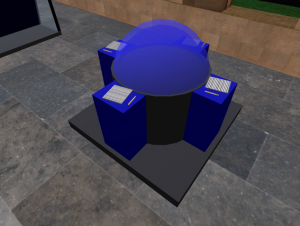 Contributed by Bob Ketner. It represents a large bowl full numbered cards, each with its own text and image corresponding to an idea. Visitors take a card from the bowl and suggest a new proposal and they give it the same number of the corresponding image or text. Each new proposal will become part of the bowl. In that way, all the initial ideas of the initial proposals will evolve towards new suggestions. The original numbering of ideas is maintained in order to be able to track the evolution of ideas. This cube is intended to analyze what are links like, that is, how the links on the internet help us make our thinking evolve.
Contributed by Bob Ketner. It represents a large bowl full numbered cards, each with its own text and image corresponding to an idea. Visitors take a card from the bowl and suggest a new proposal and they give it the same number of the corresponding image or text. Each new proposal will become part of the bowl. In that way, all the initial ideas of the initial proposals will evolve towards new suggestions. The original numbering of ideas is maintained in order to be able to track the evolution of ideas. This cube is intended to analyze what are links like, that is, how the links on the internet help us make our thinking evolve.
This is the analogic part of the proposal. The digital counterpart will be worked through and through by using Twitter hashtags, i.e, small sets of letters preceded by the symbol “#” that are used to identify tweets related to a specific topic.
What’s your point of view about security?
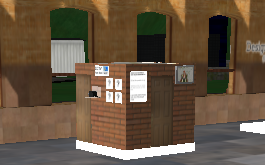 This cube is made by Marie and Stephen Crandell. It analyzes the visitors’ feelings of security in relation to past and present times. It proposes the creation of two rooms within the cube. In one of them there will be a figure representing the old “serenos” (night watchmen). There will also be a person who would open the door for you. This person is allowed to enter and leave the cube whenver she or he wills. In a second room, a CCTV camera would be installed and show its images in another part of the exhibition.
This cube is made by Marie and Stephen Crandell. It analyzes the visitors’ feelings of security in relation to past and present times. It proposes the creation of two rooms within the cube. In one of them there will be a figure representing the old “serenos” (night watchmen). There will also be a person who would open the door for you. This person is allowed to enter and leave the cube whenver she or he wills. In a second room, a CCTV camera would be installed and show its images in another part of the exhibition.
On the outer part of this cube, a white wall would encourage visitors to use graffittis to explain how they have felt while inside the cube. In particular, they will be invited to commento on which of the two experiences made them feel better (the person sneaking in side every now and then or being watched by a CCTV camera). The remaining outer walls of the cube would be used to explain how CCTV cameras work and what is their history. They also would be used to show the tweets of all those who participate in the exhibition. In that way, the boundaries of the exhibition would be pushed. This cube also propose to use some kind of hashtag (such as #cctv, for example) and to encourage anyone who has seen or come across a CCTV camera in any place to use a tweet with that hashtag to tell the rest of the wolrd where the camera was located and how he or she has felt about it. So, visitors themselves would be watching the cameras around.
Connections
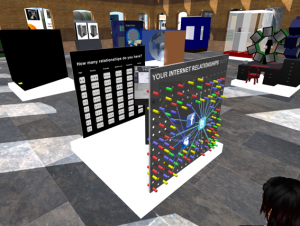 This proposal is designed with the help and support of Maria Bobes. It discusses the connections between people and social networks. These concepts are represented by two walls. On one of them the relationships that the visitors hold with other people would slowly add up by means of threads of different colours and textures tied up by visitors. On the other wall, they would be asked about how many “strong” and “weak” relationships they can maintain.
This proposal is designed with the help and support of Maria Bobes. It discusses the connections between people and social networks. These concepts are represented by two walls. On one of them the relationships that the visitors hold with other people would slowly add up by means of threads of different colours and textures tied up by visitors. On the other wall, they would be asked about how many “strong” and “weak” relationships they can maintain.
Pin Analog Scanner
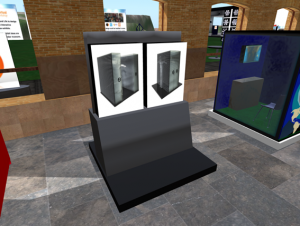 This proposal was contributed by Philip Dolman. It explores the world of work and globalization in the fields of design and construction. It is an interactive illustration of the globalization of design. It proposes to build a cloud of points for each visitor who approaches the cube, digitize it and build a small object from the resulting digitization.
This proposal was contributed by Philip Dolman. It explores the world of work and globalization in the fields of design and construction. It is an interactive illustration of the globalization of design. It proposes to build a cloud of points for each visitor who approaches the cube, digitize it and build a small object from the resulting digitization.
This proposal seems quite interesting … but what challenge to build it! Let’s see how it evolves!
Social Networks
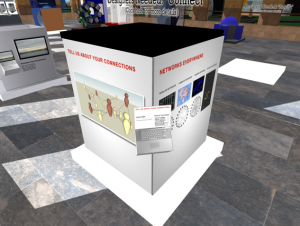 This design was made with support of Lars Stalling. On the inner part of the cube a video is shown in order to observe interactions between people. This video can be made in a participatory fashion. In fact, it would be possible to offer workshops in order to train people to make the recordings and to create videos. In this way, the visitors would end up modeling the scene showed on the cube.
This design was made with support of Lars Stalling. On the inner part of the cube a video is shown in order to observe interactions between people. This video can be made in a participatory fashion. In fact, it would be possible to offer workshops in order to train people to make the recordings and to create videos. In this way, the visitors would end up modeling the scene showed on the cube.
On the outer walls of the cube the science behind networks would be explained: types, structure, evolution … and much more more!
Digital Skies
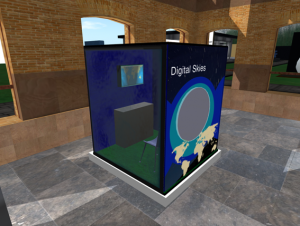 Charming proposal from Bob Ketner. It analyzes travel through space and time in the Internet era. It creates an insulated cube where visitors are asked to enter data about the place where they would like to travel and also its time zone. A screen would display images of the chosen location and the lighting system would simulate the amount of sunlight or darkness in the chosen area. If at the time of visiting the exhibiton it were night time at the selected city, you could see on the cube’s ceiling all the stars in this region at this time of the year. So, one would recreate a live global travel experience.
Charming proposal from Bob Ketner. It analyzes travel through space and time in the Internet era. It creates an insulated cube where visitors are asked to enter data about the place where they would like to travel and also its time zone. A screen would display images of the chosen location and the lighting system would simulate the amount of sunlight or darkness in the chosen area. If at the time of visiting the exhibiton it were night time at the selected city, you could see on the cube’s ceiling all the stars in this region at this time of the year. So, one would recreate a live global travel experience.
Although the visitor actually performing the virtual travel would be isolated from the outer side of the cube, other visitors on the outside of it would be able to see what was happening in the inside by means of, for example, the use of polarized glass
Thanks to this exhibition it would be possible to get Citilab and the Tech Museum more connected.
Sharing memories: photography
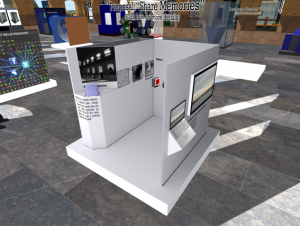 This cube was developed by the Expolab team at Citilab. Its origin comes from one of the anecdotes that were told during the Expo-design workshops. It analyzes the evolution from analog to digital cameras and its associated social impact. In the past, we only had a couple of pictures that were highly significant to us, whereas now, we have a thousand pictures of every corner. The photo developing process, based on chemical products, imposed physical constraints that prevented the excessive manipulation of photographs. Now, however, the use of semiconductors and the translation of light into ones and zeros, i.e., into the language of computers, allows us to manipulate that information easily.
This cube was developed by the Expolab team at Citilab. Its origin comes from one of the anecdotes that were told during the Expo-design workshops. It analyzes the evolution from analog to digital cameras and its associated social impact. In the past, we only had a couple of pictures that were highly significant to us, whereas now, we have a thousand pictures of every corner. The photo developing process, based on chemical products, imposed physical constraints that prevented the excessive manipulation of photographs. Now, however, the use of semiconductors and the translation of light into ones and zeros, i.e., into the language of computers, allows us to manipulate that information easily.
Within this cube the basic operation of a camera is also shown. A set of lenses that is used both by analog and digital cameras is also on display and the construction of a stenopeic camera is proposed. We encourage visitors to upload their photos via Flickr to share them with the rest of the public.
A shrinking world, growing connections
 This contribution is made by Rob Stephenson. It represents a map of the social network of a person before and after the Internet. It uses a globe to encourage visitors to map their friends and acquaintances around the world. It invites us to reflect about where were the people with whom we were related before Internet.
This contribution is made by Rob Stephenson. It represents a map of the social network of a person before and after the Internet. It uses a globe to encourage visitors to map their friends and acquaintances around the world. It invites us to reflect about where were the people with whom we were related before Internet.
The Evolution of Social Networks
This proposal has been designed by Jason Spriggs, a contributor under 18, and also a member of the Teed Greed. Jason wants to talk about how social networks started with the neighbors and have become a business.
The Introductory cube
 This cube has been codesigned by the Citilab-Expolab and Tech Tech Virtual Museum teams. We are still working to create an introductory cube that will display the whole process by which this exhibition has been made. We also will and where we will invite visitors to recommend visit itineraries to new visitors.
This cube has been codesigned by the Citilab-Expolab and Tech Tech Virtual Museum teams. We are still working to create an introductory cube that will display the whole process by which this exhibition has been made. We also will and where we will invite visitors to recommend visit itineraries to new visitors.
The image we have is still a sketch that must be improved so that visitors can get to know every person that has been involved in the creation of the first Expolab exhibition, which are many! Also we want to share with visitors the images of all the prototypes that were created in the process and all the good ideas that have been generated, since all that material is Creative Commons. Last but not least, we don’t want to create a cube where only the voice of the organizing team is heard, and that’s why the visiting recommendations are left to participation.
These are the proposals that have been more thouroughly developed. However, all along the co-design sessions and meetings in Second Life other prototypes have been created. These ideas and prototypes could be finally completed and en up making their way to the final exhibition if you vote for them. We don’t want to leave any idea out of your scrutiny!
So here you have them too:
Travel in time and space thanks to the Internet
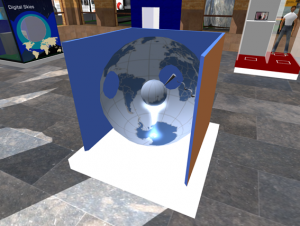
Instantaneousness: travel in time and space
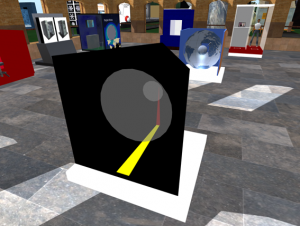
Evolution of Social Networks II
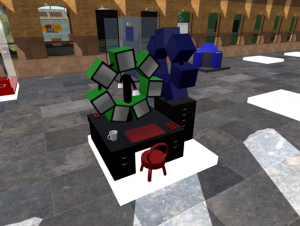
Other proposals
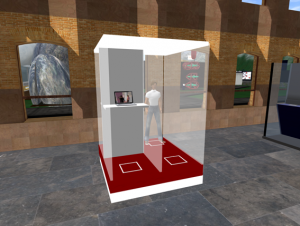
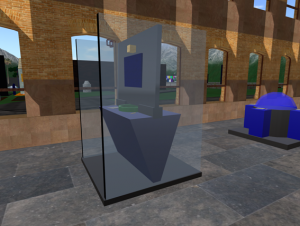
We appreciate your feedback on this blog … We also encourage you to come to Citilab on April 8th , 5 pm, to vote the proposals that you liked the most! Do not miss the opportunity to participate in this first exhibition of Expolab, a new way of understanding the exhibitions that opens them to the public! Come on, join us, tell us your opinion!




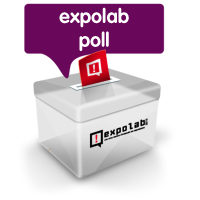
 Memory Launch
Memory Launch 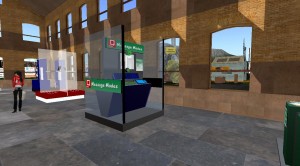


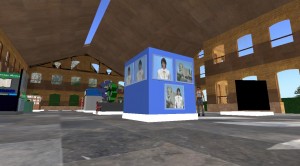


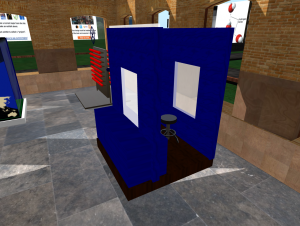
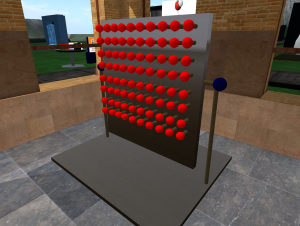








 This cube has been codesigned by the Citilab-Expolab and Tech Tech Virtual Museum teams. We are still working to create an introductory cube that will display the whole process by which this exhibition has been made. We also will and where we will invite visitors to recommend visit itineraries to new visitors.
This cube has been codesigned by the Citilab-Expolab and Tech Tech Virtual Museum teams. We are still working to create an introductory cube that will display the whole process by which this exhibition has been made. We also will and where we will invite visitors to recommend visit itineraries to new visitors.




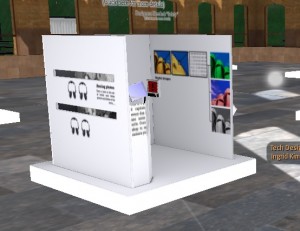
 The
The  We are organizing regular meetings with all those of you who are interested in participating in the Expolab project. The first session took place on February Friday 19th at 18pm (Barcelona time). A dozen avatars were asking questions, constructing objects on the fly and show a lot of interes in the Expolab project. If you like to have a look at these meetings, the next ones are scheduled for the upcoming Friday March 5th at 18pm (Barcelona time) and Thursday March 18th at 18pm (Barcelona time). We meet you there!
We are organizing regular meetings with all those of you who are interested in participating in the Expolab project. The first session took place on February Friday 19th at 18pm (Barcelona time). A dozen avatars were asking questions, constructing objects on the fly and show a lot of interes in the Expolab project. If you like to have a look at these meetings, the next ones are scheduled for the upcoming Friday March 5th at 18pm (Barcelona time) and Thursday March 18th at 18pm (Barcelona time). We meet you there!